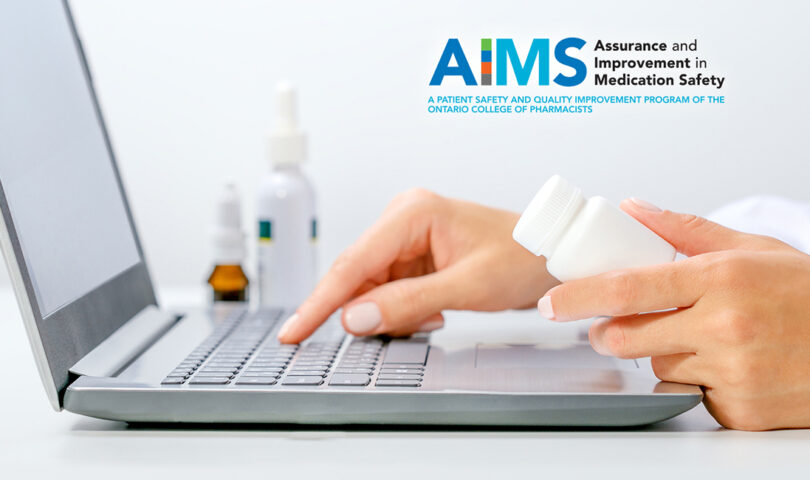This article demonstrates how pharmacy professionals can apply the AIMS Program to an incident related to the similarity of drug names that was highlighted in our Focus on Error Prevention series. Click here to read Part I of the article.
Imagine you are the pharmacist who, when speaking with the patient, catches this near miss event.
Near misses are events that could have led to inappropriate medication use or patient harm but were intercepted before they reached the patient.
Near misses create opportunities to analyze the dispensing process, enabling a better understanding of potential weaknesses which can be addressed before an actual medication incident occurs.
After remedying the situation and reassuring the patient, you are ready to investigate the near miss using the four stages of the AIMS Program:
The Four Pillars of AIMS
Pharmacy professionals may begin at different pillars of the AIMS Program and may return to pillars multiple times depending on the circumstances and analysis of the medication safety event.

ANALYZE
When a medication incident or near miss occurs, pharmacy professionals analyze the event in a timely manner for causal factors and commit to taking appropriate steps to minimize the likelihood of recurrence of the event
QUICK TIP: If you were not directly involved with the event, you may choose to discuss with staff members who were directly involved to gain a more thorough understanding of the event.In this case, you will need to talk with the pharmacy team members involved in the dispensing process to gain a complete understanding of the event.
DOCUMENT
Pharmacy professionals document appropriate details of medication incidents and near misses in a timely manner to support accuracy.
As you investigate the event be sure to document any supporting details, discussions and outcomes. This important step will ensure accurate representation of actions taken and next steps and will help inform the continuous quality improvement plan that is developed as a result of the incident or near miss. Documentation starts upon discovery of the incident or near miss and continues through the development of the CQI plan and shared learning process.
RECORD
Anonymous recording of all medication incidents and near misses by pharmacy professionals to the AIMS-Pharmapod platform is important to support quality improvement within the pharmacy, and at a system level will facilitate anonymous reporting that will identify issues and incident trends to support shared learnings.
You are now ready to record de-identified information into the AIMS-Pharmapod platform using key insights you have gained through your analyze and document stages.
QUICK TIP: The information you will need in this first step is the patient’s date of birth, gender and prescription number in addition to the prescriber’s license number and name (optional fields).Using the drop-down menu labeled “What happened? (Incident Type)”, you identify the near miss type as “incorrect drug” and describe briefly what happened from your analyze step in the free-form comment section.
The AIMS-Pharmapod platform can support multiple contributing factors per event.
In this particular case, you could select the following contributing factors in the recording platform:
- Environmental, staffing, or workflow problem
- Lack of staff education
- Lack of quality control or independent check systems
For each contributing factor identified, the AIMS-Pharmapod platform will provide further drop-down options to record additional factors that may have contributed to the near miss. In this example, under Environmental, staffing, or workflow problem, during your analysis you may have discovered that the following contributing factors were involved:
- Interruptions
- Inadequate Staffing
- Heavy workload
Finally, the near miss form includes drop-down sections for the stage of the dispensing process in which the near miss occurred – in this case the primary stage is “order entry” and the secondary stage “dispensing/preparation.”
QUICK TIP: At any time your work can be saved as a draft to facilitate form completion in busy environments.SHARE LEARNINGS
There should be prompt communication of appropriate details of a medication incident or near miss, including causal factors and actions taken as a result, to all staff. The development and monitoring of CQI plans and outcomes should be supported by the entire pharmacy team.
Thinking through the event using a structured framework enables you to better understand what happened, why it happened and where in the dispensing process it happened. This information allows for the development of impactful solutions that, once implemented, can reduce or eliminate the recurrence of similar events in the future. The recommendations above are examples of solutions that can be implemented in any pharmacy to prevent similar events. The process of thinking about medication incidents and near misses in this way promotes continuous quality improvement in your pharmacy’s work processes leading to improved patient safety and reduced patient harm. Recording incidents and near misses in the Pharmapod system also contributes towards shared learnings throughout the province and broader system improvements.
If you have any questions about the AIMS Program, please contact AIMS@ocpinfo.com.













